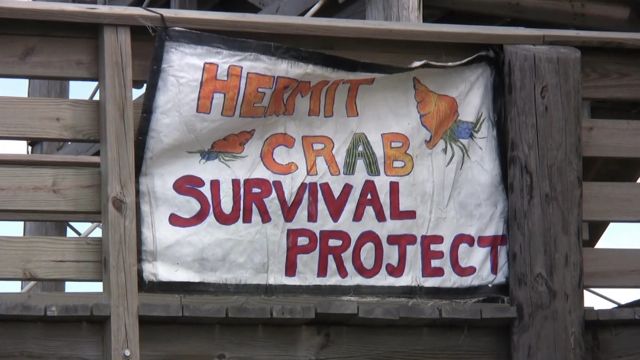

I went to Grand Isle last July during the oil spill to see how the area was doing. The beaches were all closed, and crews contracted by BP were working in the sand and patrolling in ATVs to make sure no one passed the orange-mesh fences they had constructed just beyond the sand dunes. Many questioned whether BP was limiting access for safety reasons or for public image reasons. During my visit, I had lunch at a local restaurant, walked on the edge of the beaches, and talked with some college students who were there cleaning hermit crabs for a volunteer program.
I never thought I’d see any of them again, but last September I was contacted by NHK (the publicly run Japanese Broadcasting Corporation) about putting together a short video on the volunteer response to the BP Oil Spill. They had somehow tracked down Leanne Sarco, an Interpretive Ranger at Grand Isle State Park who started the Hermit Crab Survival Project, and they wanted me to interview her and combine it with footage from Grand Isle showing the effects on the area – they’d heard it was still possible to find oil on the beaches if you dug deep enough.

When I contacted Leanne, I discovered that the project had ended just a few days earlier. Fortunately, she was moving to New Orleans, which made it easy for me to talk with her. She also had video of the volunteer activities that Frasier O’Hara, one of the volunteers, had taken over the summer.
I edited my interviews with Leanne, footage from a trip to Grand Isle, and footage of volunteer activities into a short introduction and sent it off to Japan. It eventually aired in an edited form in early-December. Unfortunately, they still haven’t posted the clip on the website for the program, so I decided to upload the rough cut and post it here:
In September, the beaches on Grand Isle State Park were closed, and workers were still handling dirty sand (or at least making a very good show of it). Other beaches on the island were open. The water and sand seemed clear, and there were even families crabbing. I dug as deep as I could with the garden spade I’d brought from home, but I couldn’t find any oil. Leanne told me later that there were still tar balls washing up onto the shore but that they were clay-colored and hard to distinguish from the surrounding sand. She made it clear that the water was not safe for fishing or crabbing. There were still BP crews driving around in ATVs, and one approached me and asked what I was filming for, but they never tried to stop me.
For the most part, life in New Orleans has gone back to the way it was before the spill. Some people are avoiding local seafood, but others are happy the oysters are back and that we don’t have to eat puny oysters from East Coast anymore. As the map of Louisiana in the video shows, Louisiana is a coastal state, but New Orleans is in no way a coastal city. Unlike Grand Isle, there was no tangible evidence of the spill: only a general feeling of helplessness as video of the broken blowout preventer played on TV and images of oil-slicked waters appeared in the paper.
Fortunately for us, there were volunteers like Leanne who were determined to help. Because of Fisheries and Wildlife regulations, unlicensed volunteers were not allowed to help with the recovery of most animals. Hermit crabs, however, were not included, so Leanne did what she could and managed to rally the volunteers who showed up at Grand Isle eager to help in any way possible.


